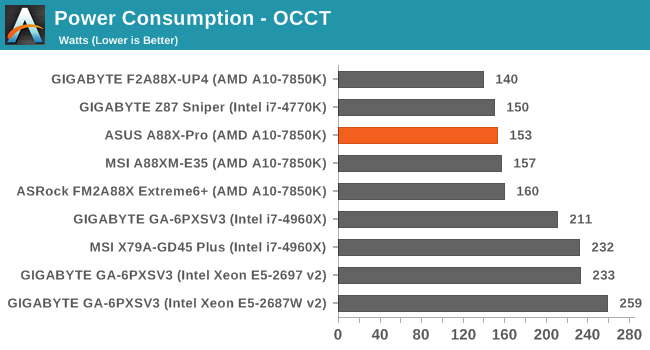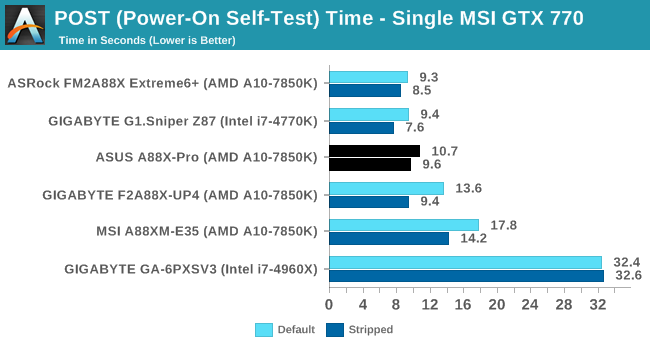ASUS A88X-Pro Review: Kaveri, Kaveri, Quite Contrary
by Ian Cutress on April 22, 2014 11:59 AM EST- Posted in
- Motherboards
- AMD
- Asus
- Kaveri
Many thanks to...
We must thank the following companies for kindly providing hardware for our test bed:
Thank you to OCZ for providing us with 1250W Gold Power Supplies and SSDs.
Thank you to G.Skill and ADATA for providing us with memory kits.
Thank you to Corsair for providing us with an AX1200i PSU, Corsair H80i CLC and 16GB 2400C10 memory.
Thank you to ASUS for providing us with the AMD HD7970 GPUs and some IO Testing kit.
Thank you to MSI for providing us with the NVIDIA GTX 770 Lightning GPUs.
Thank you to Rosewill for providing us with the 500W Platinum Power Supply for mITX testing, BlackHawk Ultra, and 1600W Hercules PSU for extreme dual CPU + quad GPU testing, and RK-9100 keyboards.
Thank you to ASRock for providing us with the 802.11ac wireless router for testing.
Test Setup
| Test Setup | |
| Processor |
AMD A10-7850K (ES) 2 Modules, 4 Threads |
| Motherboards | ASUS A88X-Pro |
| Cooling |
Corsair H80i Thermalright TRUE Copper |
| Power Supply |
OCZ 1250W Gold ZX Series Corsair AX1200i Platinum PSU |
| Memory |
AMD Gaming 2x8GB DDR3-2133 10-11-11 Kit 2 x Corsair Vengeance Pro 2x8 GB DDR3-2400 10-12-12 Kit |
| Memory Settings | XMP |
| Video Cards |
MSI GTX 770 Lightning 2GB (1150/1202 Boost) ASUS HD7970 3GB (Reference) |
| Video Drivers |
Catalyst 13.12 NVIDIA Drivers 332.21 |
| Hard Drive | OCZ Vertex 3 256GB |
| Optical Drive | LG GH22NS50 |
| Case | Open Test Bed |
| Operating System | Windows 7 64-bit SP1 |
| USB 2/3 Testing | OCZ Vertex 3 240GB with SATA->USB Adaptor |
| WiFi Testing | D-Link DIR-865L 802.11ac Dual Band Router |
Power Consumption
Power consumption was tested on the system as a whole with a wall meter connected to the OCZ 1250W power supply, while in a single MSI GTX 770 Lightning GPU configuration. This power supply is Gold rated, and as I am in the UK on a 230-240 V supply, leads to ~75% efficiency > 50W, and 90%+ efficiency at 250W, which is suitable for both idle and multi-GPU loading. This method of power reading allows us to compare the power management of the UEFI and the board to supply components with power under load, and includes typical PSU losses due to efficiency. These are the real world values that consumers may expect from a typical system (minus the monitor) using this motherboard.
While this method for power measurement may not be ideal, and you feel these numbers are not representative due to the high wattage power supply being used (we use the same PSU to remain consistent over a series of reviews, and the fact that some boards on our test bed get tested with three or four high powered GPUs), the important point to take away is the relationship between the numbers. These boards are all under the same conditions, and thus the differences between them should be easy to spot.



Power consumption on the A88X-Pro is in line with other motherboards, however the IR355x ICs of the GIGABYTE seem to have the advantage during high CPU loading.
Windows 7 POST Time
Different motherboards have different POST sequences before an operating system is initialized. A lot of this is dependent on the board itself, and POST boot time is determined by the controllers on board (and the sequence of how those extras are organized). As part of our testing, we are now going to look at the POST Boot Time - this is the time from pressing the ON button on the computer to when Windows 7 starts loading. (We discount Windows loading as it is highly variable given Windows specific features.) These results are subject to human error, so please allow +/- 1 second in these results.

With the focus on fast booting into Windows 8, there is little incentive to optimize the POST sequence for other OSes. Nevertheless we see that a good ~1/3 of ASUS’ boot time can be saved by disabling unwanted controllers.










34 Comments
View All Comments
Antronman - Tuesday, April 22, 2014 - link
It's Asus.Of course it's going to be recommended.
Every fool knows Asus is #1
yannigr - Tuesday, April 22, 2014 - link
And those who are not fools? What do they think about ASUS? :PHanzNFranzen - Wednesday, April 23, 2014 - link
lol!! =)Yorgos - Tuesday, April 22, 2014 - link
I am really happy with asrock extreme6+, which packs more features+1 64 Mbit Flash ROM (awesome feature)
+1 HDMI (4 monitors in total)
-1 eSata (instead of 2 on the asus)
-2 usb2.0
+1 Sata
+ power and reset buttons (f* great feature)
+ doesn't make you look like a pimp with gold teeth
+Wake on LAN
+ cheaper for around 20 € in my country than the asus
In my opinion you CANNOT beat those feature with a better price and better benchmarks.
That's why I never read the conclusions, If I wanted an opinion I could ask also my dog, both of them have the same value.
Alexvrb - Tuesday, April 22, 2014 - link
What about PWM (4-pin) fan headers? If I was in the market for this kind of board, this A88X Pro would be the one I'd get, just because of its abundance of 4-pin connectors (5 of them). Most ATX A88X boards have... 3? With maybe one or two 3-pins to go with them. Yeah, you can get splitters (better get well-made ones) but then you can only monitor the speed of one of the connected fans per motherboard header.Antronman - Wednesday, April 23, 2014 - link
Yeah.And it's ASUS quality.
Alexvrb - Wednesday, April 23, 2014 - link
Which, most of the time, means it's good. I've been burned over the years by most of the major manufacturers at least once, including Asus. Sometimes it's a hardware/design issue, sometimes it's software/firmware. On occasion it was a problem with the chipset itself, and not entirely the manufacturers fault. About the most solid boards I used were by Epox, hilariously enough.But yes, overall I'd consider Asus to generally produce good boards, particularly if you're buying one of their "premium" models.
tuklap - Friday, April 25, 2014 - link
I just hope Asrock placed anti surge ic's and esd protections :(just4U - Tuesday, April 22, 2014 - link
In my opinion none of this matters until they finally release the A8- 7X series processors. Don't know about the rest of you but I've been eyeing it for multiple builds simply because of it's price/performance ratio. I'd expected it to be release already.HiTechObsessed - Tuesday, April 22, 2014 - link
My problem with these APUs is something like the A10-7850k costs $180, or you can get the 750k for $80, and a 7770 GHz for $100 and blow the 7850k out of the water in performance. APUs don't make sense on large boards like this when you can pair the same CPU up with a dedicated GPU and get much more gaming power.